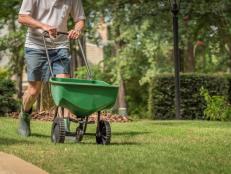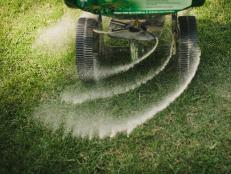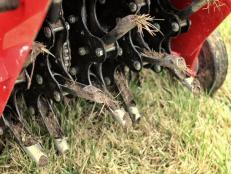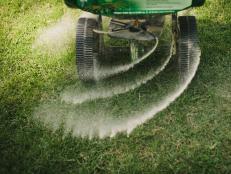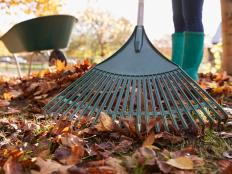Plugging and Sprigging a Lawn
Learn how to start a brand-new warm-season lawn or patch an existing one using plugs or sprigs.

Image courtesy of Ben Rollins
Materials Needed
- sterilized compost
- lawn starter fertilizer
- soil amendments, as needed
- steel rake
- rotary tiller
- sprinkler
- plugs or sprigs of grass
- wooden stakes and string
- tape measure
- trowel or bulb planter
- hoe
- water-filled lawn roller
Step 1: Prepare the Soil
Remove all weeds and undesirable plants from the soil. If starting a new lawn, spread 1 to 2 inches of compost over the area. Also apply fertilizer formulated for new lawns, as well as lime or sulfur if indicated by a soil test. Moisten the soil slightly, then rotary-till everything into the top 3 to 6 inches of soil; rake smooth. If necessary where you live, check that your sprinklers cover the area evenly.
Step 2: Order the Plugs or Sprigs
Late spring to early summer is the best time to plant. Tell the nursery how many square feet of lawn you have, and the nursery will order the correct number of trays of plugs or bushels of sprigs. When the order arrives, plant as soon as possible, keeping plugs or sprigs lightly moist and cool.
Step 3: Make a Planting Grid
Use stakes and string to mark out rows. Space plug rows 6 to 12 inches apart, depending on the grass. Spacing plugs and sprigs closer together gives you a full lawn but is more expensive. Space plugs of slower-growing species, such as zoysia, closer together. Along each row, use a trowel or bulb planter to make sufficiently deep (usually 1 to 2 inches deep) planting holes 6 to 12 inches apart to form a grid. For sprigs, use a hoe to make 1- to 2-inch-deep furrows spaced 10 to 18 inches apart. Most likely instructions will come with your order with more details.
Step 4: Install the Plants
Set plugs into the holes and firm the soil around them. With sprigs, lay them 4 to 6 inches apart in the furrows, with the leafy sides up; fill in the furrows, burying the bottom two-thirds of the plants.
Step 5: Rake, Roll and Water
Rake the planted area carefully to smooth the soil without disturbing the plants. Roll with a half-filled lawn roller. If a lawn roller is not available, press plugs into firm contact with soil with your feet. Keep the soil evenly moist as the plants grow new roots and leaves begin to spread. Hoe out weeds as they appear. Begin mowing when the lawn is firmly rooted, a month or two after planting. To avoid damage, set mower blades higher than usual until the lawn is fully filled in.






